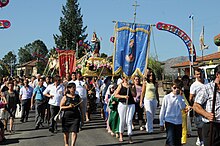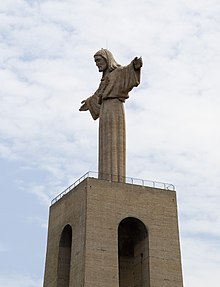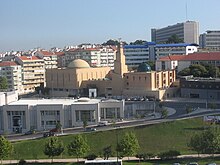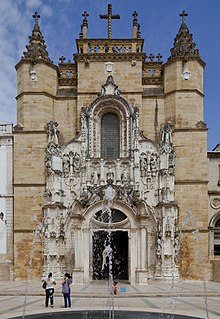Religion in Portugal
According to the 2021 Census, 80.2% of the population of Portugal is Catholic, though in 2001 only about 19% attended Mass and took the sacraments regularly,[2] while a larger number wish to have their children baptized, be married in a church, and receive Last Rites.[7] Although Church and State are formally separated since 1911, the Roman Catholic precepts continue to have a significant bearing in Portuguese society and culture.The educational and health care systems were for a long time the Church's preserve, and in many cases, whenever a building, bridge, or highway was opened, it received a blessing from the clergy.It is also in the regions of Lisbon and the Algarve that the highest proportions of members of other Christian churches, of other religions and of people without religious affiliation are found.The municipalities with the highest percentages are Mesão Frio (97.0%), Ribeira de Pena (96.5%), Resende (96.4%) and Baião (96.3%) in the North region, and Vila Franca do Campo (96.3%) in the Azores.The least Catholic municipalities are located in the Algarve and on the Alentejo coast with Lagos (55.2%), Vila do Bispo (56.1%), Sines (56.2%), Aljezur (56.3%) and Odemira (56.7%) with the lowest percentages .The municipalities with the highest proportions of members of other Christian denominations are Lagos (14.3%), Albufeira (13.2%), Portimão (12.7%), Loulé (11.3%) and São Brás de Alportel (11.0%), all in the Algarve.During this period, Bracara Augusta (the modern city of Braga) became one of the most important episcopal centres, alongside Santiago de Compostela.[12] In the early fifth century, Paulus Orosius, a friend of Saint Augustine, born in Braga, wrote several theological and historical works of great importance.[citation needed] Under Afonso Henriques (r. 1139–1185), the first king of Portugal and the founder of the Portuguese Kingdom, church and state were unified into a lasting and mutually beneficial partnership.In the 13th and 14th centuries, the Church enjoyed both riches and power stemming from its role in the reconquest and its close identification with early Portuguese nationalism.For a time, the Church's position vis-à-vis the State diminished until the growth of the Portuguese Overseas Empire made its missionaries important agents of colonization (see, for example, Kingdom of Kongo).In 1497, reflecting events that had occurred five years earlier in Spain, Portugal expelled the Jews and the few remaining Moors — or forced them to convert.The Marquês de Pombal (r. 1750–1777) expelled the Jesuits in 1759, broke relations with the Holy See in Rome, and brought education under the State's control.With the outbreak of the First World War the Portuguese First Republic viewed it as a unique opportunity to achieve a number of goals: putting an end to the twin threats of a Spanish invasion of Portugal and of foreign occupation of the colonies and, at the internal level, creating a national consensus around the regime.By the mid-1920s the domestic and international scenes began to favour an authoritarian solution, wherein a strengthened executive might restore political and social order.In addition, Salazar's corporatist principles and his constitution and labour statute of 1933 were infused with Roman Catholic precepts from the papal encyclicals Rerum novarum (1891) and Quadragesimo anno (1931).The Concordat of 1940 reversed many of the anticlerical policies adopted during the First Republic, and the Catholic Church was given exclusive control over religious instruction in the public schools.Dissent and criticism were forbidden; those clergy who stepped out of line — an occasional parish priest and once the Bishop of Porto — were silenced or forced to leave the country.The rest of the Roman Catholic Church hierarchy, led by Cardinal Manuel Gonçalves Cerejeira, a great friend and supporter of Salazar, remained silent on the issue.By the early 1990s, most Portuguese still considered themselves Roman Catholic in a vaguely cultural and religious sense, but only about one-third of them attended Mass regularly.By the early 1990s, however, the Roman Catholic Church no longer enjoyed this pre-eminence but had fallen to seventh or eighth place in power among Portuguese interest groups.[citation needed] Much of the country's religious life has traditionally taken place outside the formal structure and official domain of the Roman Catholic Church.The most famous religious event in Portugal has been the claimed apparition of the Virgin Mary to three children in Cova da Iria, in the village of Fátima, in 1917.[13] The apparition of the Heavenly Mother in this small village in the district of Santarém has led hundreds of thousands of pilgrims to visit the Sanctuary of Our Lady of Fátima each year, many in the hope of receiving healing.The widespread use of folk practices and the humanization of religion made for a loving though remote God, in contrast to the harshness of the Spanish vision.The establishment of a constitutional monarchy in 1834 granted limited religious toleration, and consequently led to the opening of an Anglican chapel (St. George's Church, Lisbon).Congregations were created from Roman Catholic priests and laypeople who refused to accept the dogmas of the infallibility and universal ordinary jurisdiction of the Pope, as defined by the First Vatican Council in 1870.[21] The population of the Baháʼí community Ain Portugal was estimated at some 2,100 members in 2010 according to the Association of Religion Data Archives (relying on World Christian Encyclopedia).It is also possible to find in the Metropolitan Areas of all the regions several Hare Krishna communities, consisting mainly of non-Portuguese Europeans, Brazilians, US citizens and a few Portuguese.




CatholicismProtestantismJehovah's WitnessesChristianHinduismBuddhismJudaismChurch of the Holy CrossCoimbraChristianityPortugalsecular statesacramentsbaptizedLast Ritesexistence of Godreligion is importantPew Research CenterChurch and StatecultureclergyCatholic Church in PortugalCatholicProtestantMuslimBuddhist- IslamNo religionAzoresMadeiraAlgarveLisbonnon-religiousCentralLisbon Metropolitan AreaAlentejomunicipalitiesMesão FrioRibeira de PenaResendeBaiãoVila Franca do CampoVila do BispoAljezurOdemiraAlbufeiraPortimãoLouléSão Brás de AlportelOdivelasAmadoraGrândolaAljustrelPortugueseCatholicsunaffiliatedreligiousbasic levels of educationCatholic Churchrural areasurban areasBraga CathedralRoman EmpirePre-Roman populationsRoman mythologyProto-CelticCelticLusitaniansLusitanian mythologySephardiRoman ProvincesLusitaniaGallaeciaBracara AugustaepiscopalSantiago de CompostelaVisigothsGermanic tribesIberian PeninsulaArian heresyPriscillianistArchbishops of BragaHispaniaSaint OvidiusPaulus OrosiusSaint AugustineSaint Martin of BragaArianismEcumenical Councils were held in BragaMoorishAl-AndalusUmayyad conquest of HispaniaMozarabic RitereconquestVímara PeresFirst County of PortugalAfonso Henriquesking of PortugalPortuguese Kingdompapal bullManifestis Probatumnobilitymilitary orders13th and 14th centuriesPortuguese Overseas EmpiremissionariescolonizationKingdom of KongoIsaac Abrabanelexpelled the JewsJoão IIIPortuguese InquisitionJesuit OrderMarquês de Pombalexpelled the JesuitsHoly Seeanti-clericalismreligious ordersPortuguese First RepublicFirst World WarEstado NovocorporatisttotalitarianAntónio de Oliveira SalazarseminarianUniversity of Coimbra
